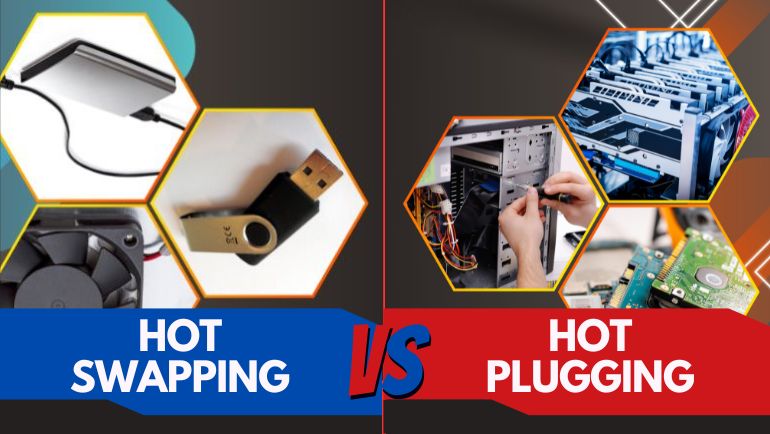
Hot swaps and hot plugs are often used interchangeably with each other, but there is a subtle difference between hot swaps and hot plugs. Hot swapping is used to replace a device without turning off the system, while hot-plugging is used to plug in any device without static shock. Here we will cover some key differences between hot plugging and hot swapping in detail.
Hot Swapping vs Hot Plugging – What’s the difference?
Hot swap and hot plug devices are crucial for zero downtime enterprises as they are scalable, cost-effective, and easy to use. However, their features and uses vary from system to system. Let’s discuss them in detail:
Hot Swapping vs. Hot Plugging: Device Addition and Removal

Hot swapping or cold swapping allows you to add or remove internal devices from the system without shutting it off. It reduces the chances of an electric shock during hardware replacement. Whereas, hot plugs are external devices that provide safer ejection of hardwares from the system. This feature minimizes the risk of data corruption and loss.
Hot Swapping vs. Hot Plugging: Device Management
Most machines can configure the hot plug and hot swap device automatically, which makes it easier to manage and configure them. However, sometimes, the user may have to configure them manually.
Hot Swapping vs. Hot Plugging: Compatibility

Hot plugging devices are more compatible with different machines than hot swapping. This is because most machines do not support the hot-swapping feature. They are usually installed in high and mid-level machines like PC servers or network switches.
Hot Swapping vs. Hot Plugging: User Experience
Hot plugging devices are user-friendly, as they connect to the system automatically via the plug-and-play feature. Whereas, hot-swapping devices may require some technical skills to configure. Hence, making it more complex.
Hot Swapping vs. Hot Plugging: Cable Clutter

Hot-swapping devices have more cable clutter because they are usually connected to a cable, while hot-plugging is directly attached to the system board. Hence, less clutter and more speed.
Hot Swapping vs. Hot Plugging: Power Cycling Requires
Power cycling turns off a system or device for a short time to prevent electric surges. However, both hot plug and hot swap devices are specifically designed to limit it. That said, they do not require power cycling.
Best Hot Swapping and Hot Plugging Devices
As discussed, hot plug and hot swap devices are crucial for a zero downtime system. That said, here is the list of the best hot-swappable and hot-pluggable devices from Computing Worlds for sale.
Popular Hot Pluggable Devices
Popular Hot Swappable Devices
You can also request a bulk quote online for the required hot swapping and hot plugging devices.
Frequently Ask Questions:
Which One is Better Hot Plug vs. Hot Swap?
Hot swaps are better than hot plugs as they replace faulty parts during operation without downtime.
What is The Disadvantage of a Hot Swap?
The biggest disadvantage of hot swapping is that it requires compatible hardware support.
What is The Disadvantage of a Hot Plug?
The disadvantage of hot plugging is that it may cause data corruption if not performed correctly.
It is important to understand the difference between hot plug and hot swap devices because it directly relates to your system performance. They provide flexible hardware management and maintenance in zero downtime systems. As usual, it is suggested to evaluate your requirements before buying. For more updates on various device features, stay connected with the Computing Worlds blog.






